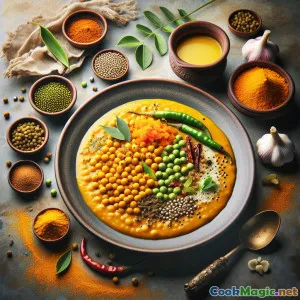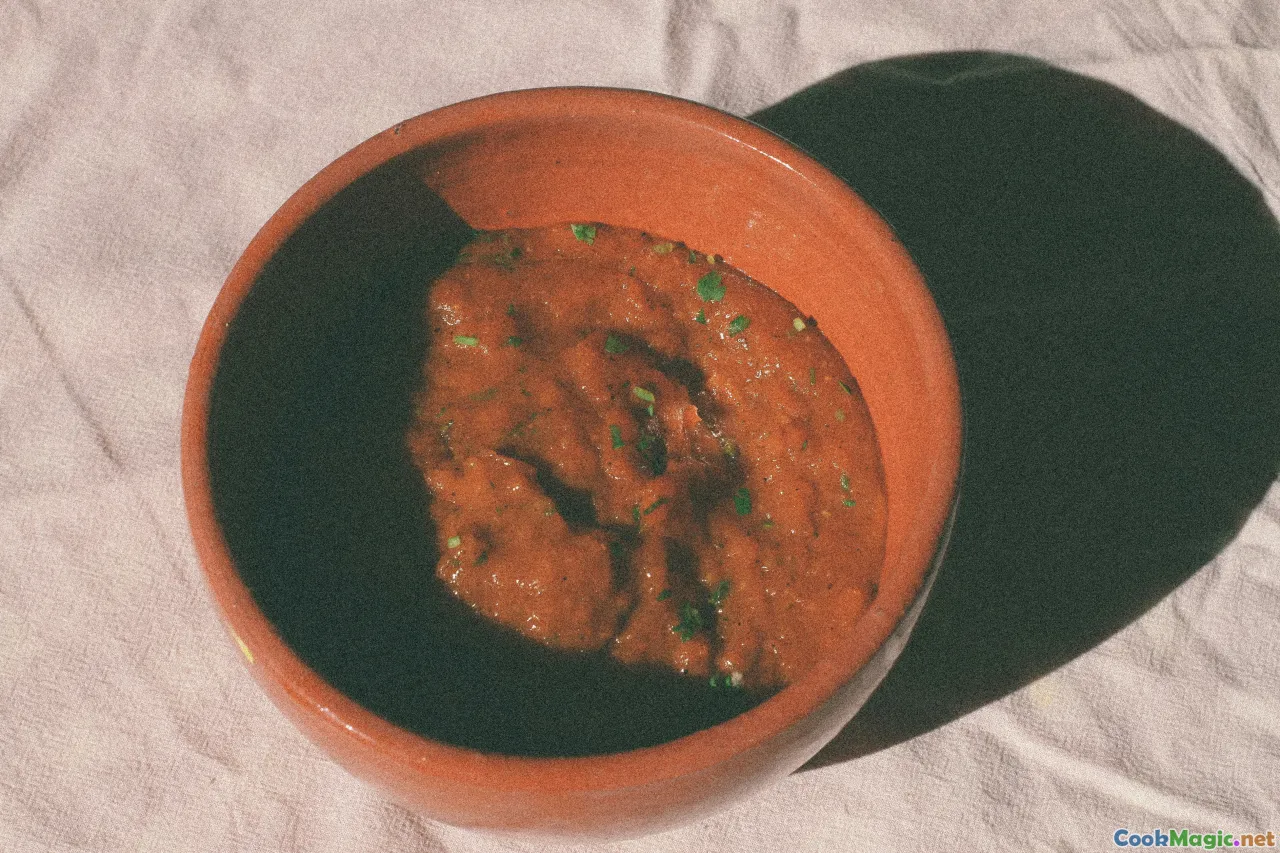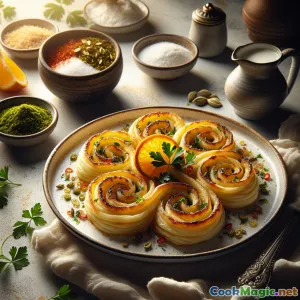
Tuver Dal Rasawala: Przyprawione gujaratijskie curry z soczewicy
(Tuver Dal Rasawala: Spiced Gujarati Lentil Curry)
(0 Recenzje)0
162
październik 17, 2025
Zgłoś problem
Składniki
-
200 grams Toor/tuver dal (dzielona fasola gołębia)
(Rinse well and soak 20 minutes for quicker, creamier cooking)
-
800 ml Woda
(For pressure-cooking the dal; adjust later for consistency)
-
0.5 tsp Proszek Kurkumy
(Adds color and earthiness)
-
2 tbsp Ghee lub neutralny olej
(Ghee gives classic flavor; substitute oil for vegan)
-
0.5 tsp Nasiona gorczycy
(For nutty, crackling tempering)
-
1 tsp Nasiona kminu
(Balances the sweetness of the dal)
-
0.25 tsp Asafetyda (Hing)
(Essential Gujarati aroma; use gluten-free hing if needed)
-
12 leaves Liście curry
(Fresh leaves give the best aroma)
-
2 pieces Zielone chili
(Slit lengthwise; adjust heat to taste)
-
1 tbsp Imbir (starty)
(Bright, warming flavor)
-
3 cloves Ząbki czosnku, posiekane
(Skip for no-onion/garlic version)
-
2 pieces Pomidory drobno posiekane
(Medium ripe tomatoes for gentle tang)
-
0.75 tsp Czerwony Pieprz Mielony
(Use Kashmiri for color and mild heat)
-
1.5 tsp Proszek kolendrowy
(Adds citrusy depth)
-
0.5 tsp Proszek kminowy
(Boosts the spice base)
-
1 tbsp nie refinowany cukier trzcinowy, starty
(Balances tamarind’s tang; adjust to taste)
-
1 tbsp Pulpa tamaryndowa
(Classic Gujarati sweet-sour balance)
-
2 pieces Suszony owoc kokum (Garcinia indica)
(Optional alternative to tamarind; use either, not both)
-
1 tsp Sól
(Dostosuj do smaku)
-
2 tbsp Świeża kolendra (cilantro), posiekana
(For freshness at the end)
-
1 tsp Sok cytrynowy
(Optional bright finish if not using tamarind)
-
0.5 tsp Kasuri methi (suszone liście kozieradki), rozgniecione
(Adds mellow bitterness and aroma)
-
250 ml Gorąca woda (do regulowania konsystencji)
(Add as needed for a rasawala (soupy) finish)
-
2 tbsp Prażone orzeszki ziemne
(Traditional texture add-in; omit for nut-free)
(Rinse well and soak 20 minutes for quicker, creamier cooking)
(For pressure-cooking the dal; adjust later for consistency)
(Adds color and earthiness)
(Ghee gives classic flavor; substitute oil for vegan)
(For nutty, crackling tempering)
(Balances the sweetness of the dal)
(Essential Gujarati aroma; use gluten-free hing if needed)
(Fresh leaves give the best aroma)
(Slit lengthwise; adjust heat to taste)
(Bright, warming flavor)
(Skip for no-onion/garlic version)
(Medium ripe tomatoes for gentle tang)
(Use Kashmiri for color and mild heat)
(Adds citrusy depth)
(Boosts the spice base)
(Balances tamarind’s tang; adjust to taste)
(Classic Gujarati sweet-sour balance)
(Optional alternative to tamarind; use either, not both)
(Dostosuj do smaku)
(For freshness at the end)
(Optional bright finish if not using tamarind)
(Adds mellow bitterness and aroma)
(Add as needed for a rasawala (soupy) finish)
(Traditional texture add-in; omit for nut-free)
Wartości odżywcze
- Porcje: 4
- Wielkość porcji: 1 bowl (250 ml)
- Calories: 255 kcal
- Carbohydrates: 0 g
- Protein: 12 g
- Fat: 8 g
- Fiber: 9 g
- Sugar: 6 g
- Sodium: 620 mg
- Cholesterol: 10 mg
- Calcium: 90 mg
- Iron: 3.2 mg
Instrukcje
-
1 - Rinse and soak the dal:
Rinse tuver dal in several changes of water until it runs clear. Soak for 20 minutes to ensure even, creamy cooking and reduce boiling time.
-
2 - Pressure-cook the dal:
Drain dal and add to a pressure cooker with 800 ml water and turmeric. Cook for 6–7 whistles (stovetop) or 8–10 minutes on high pressure (Instant Pot), then let pressure release naturally.
-
3 - Mash to silky smoothness:
Open cooker and whisk or mash the dal until creamy. If very thick, loosen with a splash of hot water to a pourable consistency.
-
4 - Bloom whole spices:
Heat ghee in a wide pot. Add mustard seeds; when they crackle, add cumin seeds. Once aromatic, sprinkle in hing to bloom briefly.
-
5 - Sizzle aromatics:
Add curry leaves, slit green chilies, ginger, and garlic. Sauté 1–2 minutes until glossy and fragrant without browning the garlic.
-
6 - Build the masala base:
Stir in chopped tomatoes, red chili powder, coriander powder, and cumin powder. Cook until tomatoes soften and the oil or ghee begins to separate.
-
7 - Combine dal and simmer:
Pour the mashed dal into the pot. Add salt and 150–250 ml hot water for a rasawala (soupy) consistency. Simmer gently, stirring so it doesn’t stick.
-
8 - Add sweet-sour balance:
Stir in tamarind pulp and jaggery. If using kokum instead, add it now and simmer 3–4 minutes to infuse. Taste and adjust sweetness or tang.
-
9 - Finish and Garnish:
Fold in kasuri methi (if using), roasted peanuts (optional), and chopped coriander. Add a squeeze of lemon if you want extra brightness.
-
10 - Rest and Serve:
Switch off heat and rest 2 minutes for flavors to settle. Serve hot with steamed rice, jeera rice, or soft rotli/chapati.
Rinse tuver dal in several changes of water until it runs clear. Soak for 20 minutes to ensure even, creamy cooking and reduce boiling time.
Drain dal and add to a pressure cooker with 800 ml water and turmeric. Cook for 6–7 whistles (stovetop) or 8–10 minutes on high pressure (Instant Pot), then let pressure release naturally.
Open cooker and whisk or mash the dal until creamy. If very thick, loosen with a splash of hot water to a pourable consistency.
Heat ghee in a wide pot. Add mustard seeds; when they crackle, add cumin seeds. Once aromatic, sprinkle in hing to bloom briefly.
Add curry leaves, slit green chilies, ginger, and garlic. Sauté 1–2 minutes until glossy and fragrant without browning the garlic.
Stir in chopped tomatoes, red chili powder, coriander powder, and cumin powder. Cook until tomatoes soften and the oil or ghee begins to separate.
Pour the mashed dal into the pot. Add salt and 150–250 ml hot water for a rasawala (soupy) consistency. Simmer gently, stirring so it doesn’t stick.
Stir in tamarind pulp and jaggery. If using kokum instead, add it now and simmer 3–4 minutes to infuse. Taste and adjust sweetness or tang.
Fold in kasuri methi (if using), roasted peanuts (optional), and chopped coriander. Add a squeeze of lemon if you want extra brightness.
Switch off heat and rest 2 minutes for flavors to settle. Serve hot with steamed rice, jeera rice, or soft rotli/chapati.
Więcej o: Tuver Dal Rasawala: Przyprawione gujaratijskie curry z soczewicy
Tuver Dal Rasawala: A Gujarati Hug in a Bowl
Tuver Dal Rasawala is the kind of dish that turns a plain meal into something soul-satisfying. “Rasawala” literally means “with gravy,” and this recipe celebrates the Gujarati preference for a pourable, almost soup-like dal that blankets rice or pairs effortlessly with soft rotli. The hallmark of Gujarati dal is its beautiful sweet-sour-spicy balance: the nuttiness of tuver (toor) dal, the tang of tamarind or kokum, a gentle sweetness from jaggery, and the perfume of curry leaves and hing blossoming from a lively tadka.
What Makes This Dal Special
- Sweet-tangy balance: A touch of jaggery tempers the tamarind, creating the signature Gujarati profile.
- Rasawala consistency: Thinner than many dals, it’s meant to be sipped or ladled generously over rice.
- Aromatic tempering: Mustard and cumin crackle in ghee, followed by hing and curry leaves—aromas that signal comfort in Gujarati homes.
- Versatility: Adjust heat with chilies, swap tamarind for kokum, go vegan by using oil, or make a no-garlic version for festival days.
Ingredient Notes and Technique Tips
- Dal prep: A brief soak (even 15–20 minutes) helps the lentils cook evenly and mash into a silky base. Rinse until water runs clear to remove excess starch.
- Pressure cooking: Tuver dal becomes creamy quickly under pressure. On a stovetop cooker, 6–7 whistles is a solid guide; in an Instant Pot, 8–10 minutes on high with natural release works well.
- The tadka: Heat matters. Add mustard to hot ghee, let it pop, then cumin, then hing. This sequencing unlocks maximum aroma without burning delicate spices.
- Tomatoes and powdered spices: Cooking this base until the ghee separates prevents a “raw” spice taste and builds body in a naturally thin dal.
- Sweet-sour choice: Use tamarind pulp for a familiar tang. If you prefer a softer, fruitier acidity, try kokum petals (soak and simmer to infuse). Don’t use both at full strength; adjust gently.
- Consistency: Rasawala is pourable. Thin with hot water a little at a time, remembering it thickens slightly as it cools.
- Finishing touches: Cilantro brightens. A whisper of kasuri methi adds mellow, tea-like bitterness that rounds sweetness. A squeeze of lemon is optional—especially if your tomatoes weren’t very tangy.
Serving Suggestions
- Classic: Over steamed rice with a side of papad and a wedge of lime.
- Thali style: Alongside rotli, shaak (vegetable), kachumber (salad), and pickle for a balanced Gujarati plate.
- Cozy bowl: Sip it like soup with a swirl of ghee and a sprinkle of chili flake on a chilly evening.
Make-Ahead, Storage, and Freezing
- Make-ahead: Dal often tastes better a few hours later as flavors meld. If prepping in advance, keep it slightly thicker to account for thinning when reheating.
- Storage: Refrigerate in an airtight container for up to 3 days. Thin with hot water when reheating and re-check seasoning.
- Freezing: Freeze up to 2 months. Thaw overnight, simmer gently, and finish with fresh cilantro and a quick tadka for revived aroma.
Dietary and Nutrition Notes
Tuver dal is naturally rich in plant protein and fiber, with a moderate glycemic impact when paired with whole grains like brown rice or millet rotis. Ghee adds roundness but can be reduced or replaced with oil. Hing offers digestive benefits and a signature aroma; gluten-free hing is widely available if needed. Peanuts add texture and satiety but are optional for nut-free diets.
Per serving, you can expect a balanced bowl—protein from the dal, modest fat, and plenty of fiber. The jaggery isn’t just for sweetness; it rounds the acidity and enhances overall flavor depth while still keeping sugars moderate.
Cultural Significance
In Gujarat, dal isn’t merely a side—it’s the anchor of a meal. Every region has its take, but Gujarati dal stands apart for its deft sweet-sour interplay, rooted in regional taste and climate. Kokum, native to the western coast, brings cooling properties suited to warmer weather, while jaggery anchors the palate with mineral sweetness. This dal often appears on daily tables and at celebratory spreads alike, comforting yet festive with its glossy tempering and saffron-tinged hue.
Variations to Try
- Jain-friendly: Omit garlic (and even ginger, if required). Increase hing slightly for aroma.
- Peanut pop: Simmer a handful of roasted peanuts for crunch, a common Gujarati addition.
- Tomato-forward: Increase tomatoes and reduce tamarind for a fresh, bright tang.
- Extra smoky: Finish with a quick temper of ghee, cumin, and Kashmiri chili poured over just before serving.
Chef’s Notes
I aim for a balance where no single element shouts. Taste at three checkpoints: after the masala base cooks, after adding dal, and after sweet-sour adjustments. Each time, nudge toward harmony rather than intensity. If it’s too tangy, add a pinch more jaggery; if it’s too sweet, a splash of tamarind or lemon brightens. Thin it to a ladle-friendly flow—you want it to puddle gently around rice, not sit in a mound.
Above all, respect the aroma. The quiet bloom of hing and the bright jump of curry leaves are the soul of Tuver Dal Rasawala. When those notes rise from the pot, you’ll know you’ve cooked it right.




















